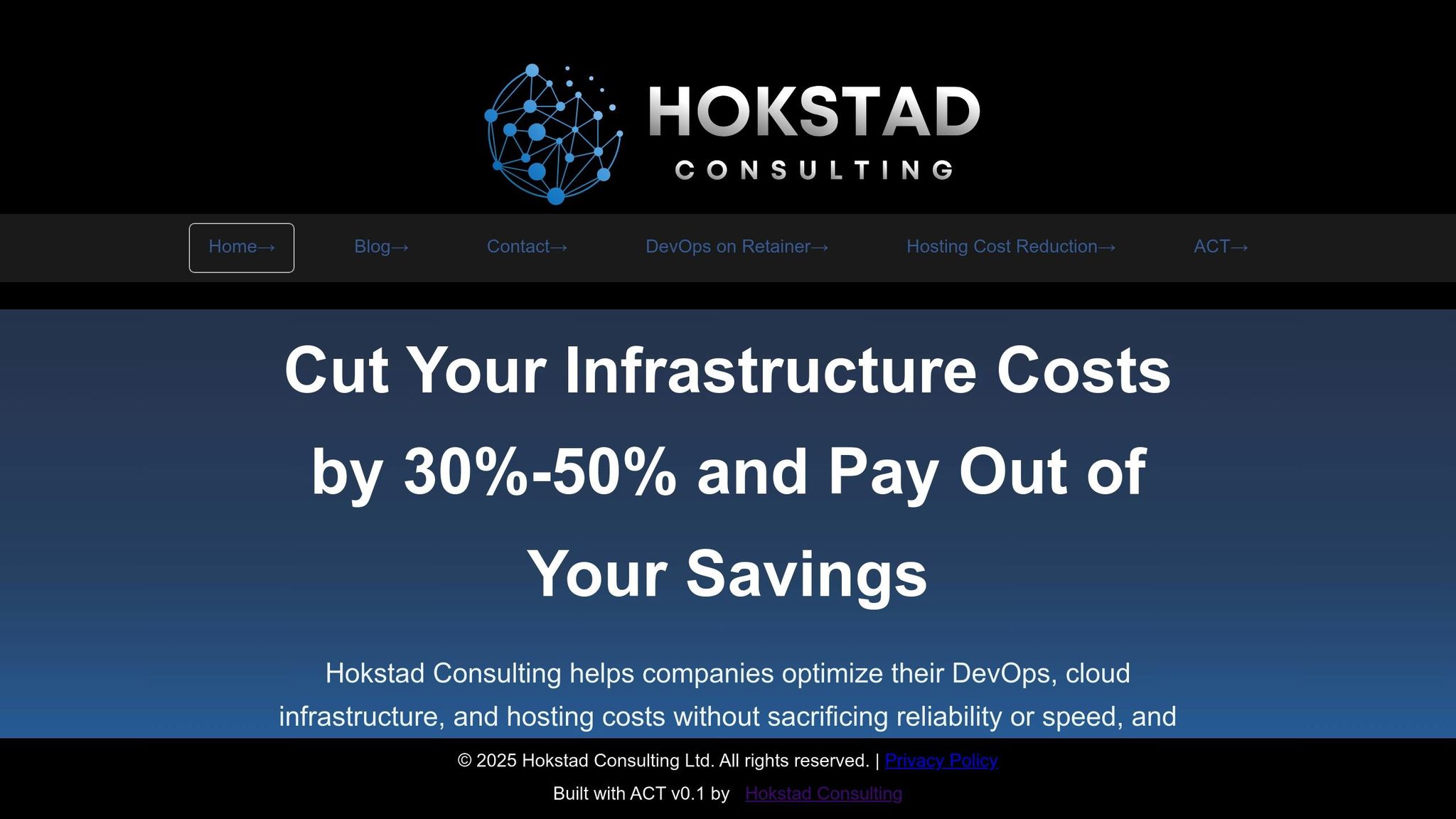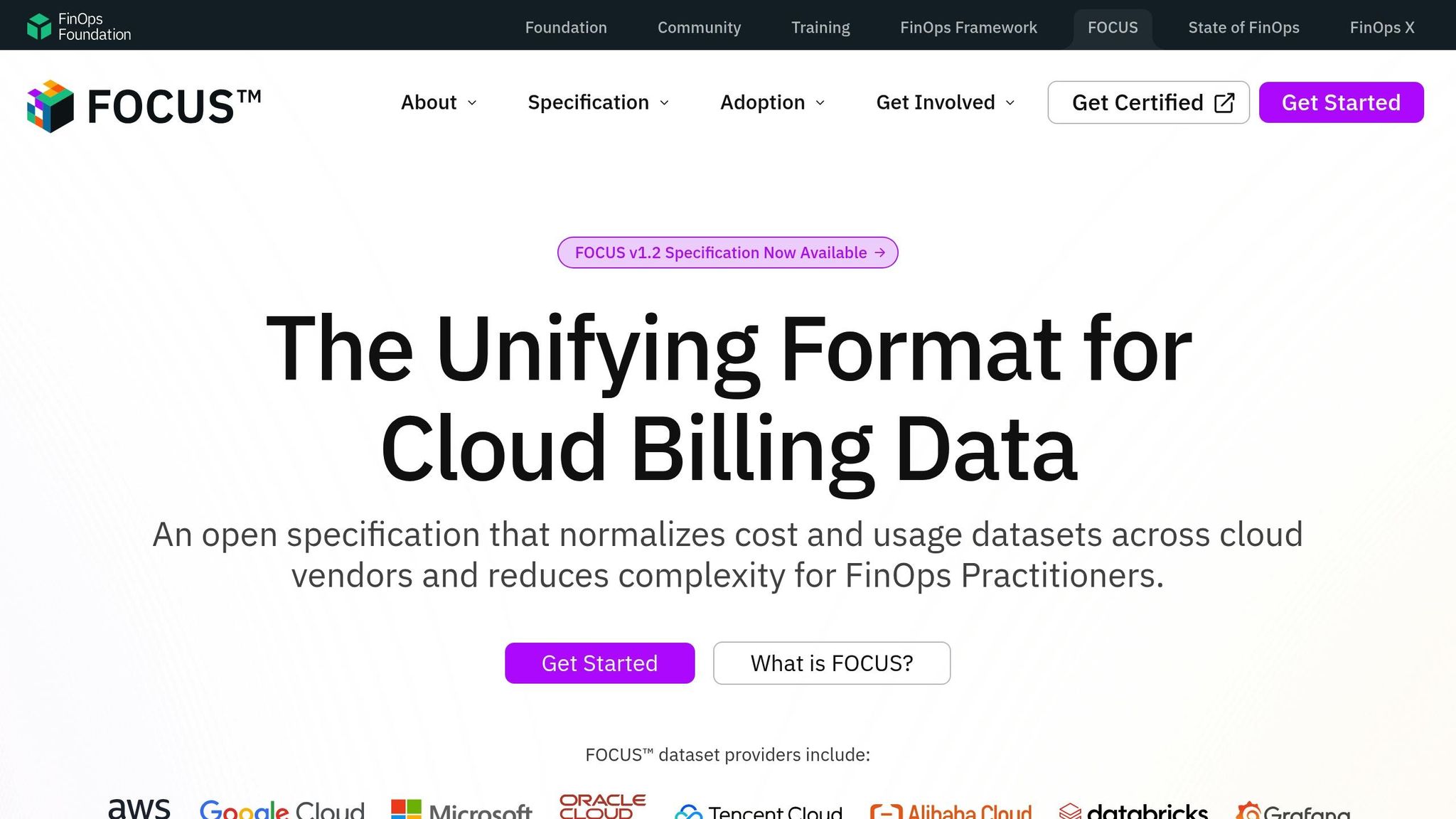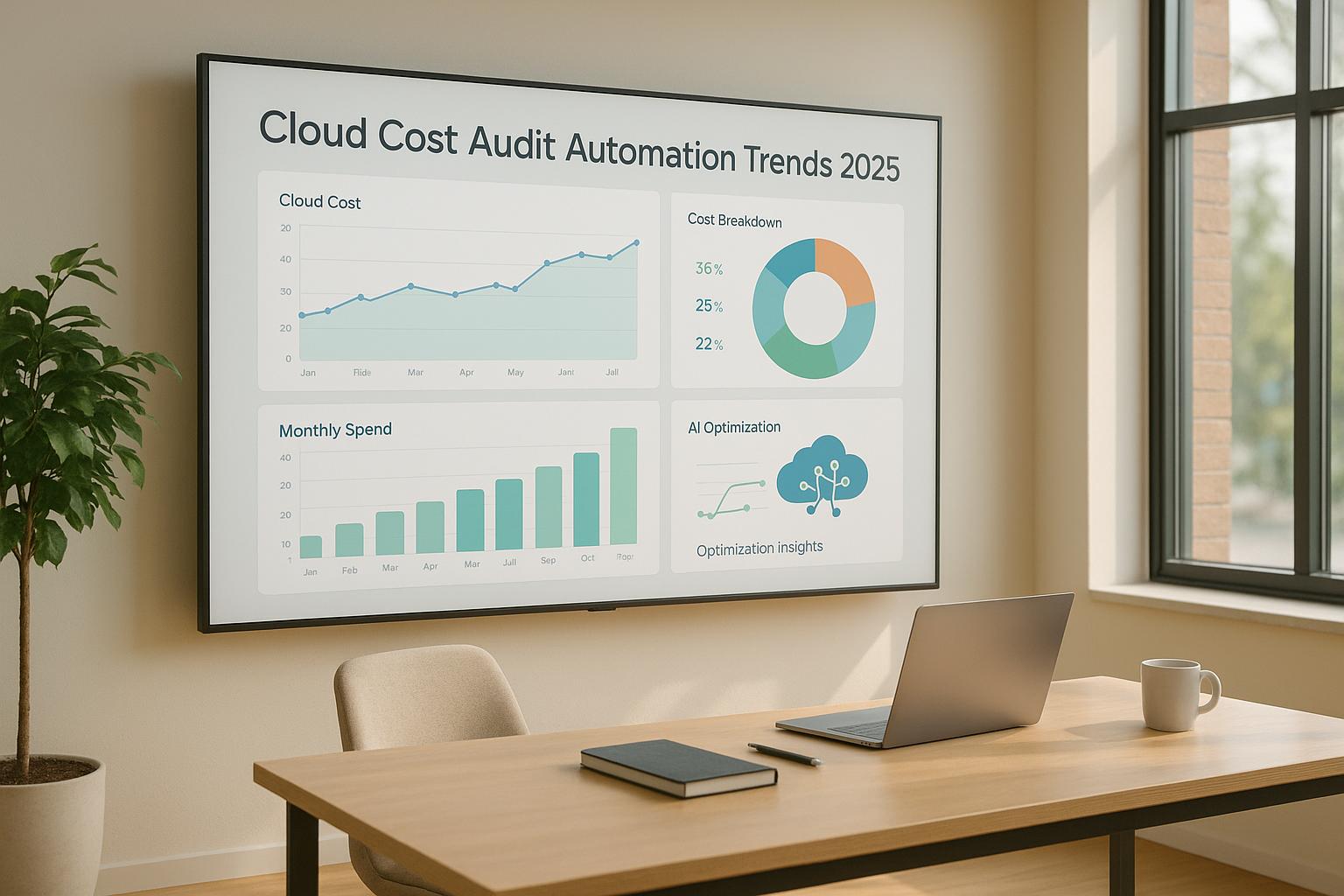Cloud costs are spiralling, and manual management can’t keep up. In 2025, UK businesses face rising cloud expenses, with 42% predicting over 10% increases this year. Automated cloud cost audits are stepping in to tackle inefficiencies, saving up to 50% on costs compared to manual processes. These systems use AI to monitor spending in real-time, detect anomalies, and optimise resources dynamically - key for managing complex multi-cloud setups.
What you need to know:
- Why it matters: 1 in 5 UK businesses now finds cloud costs
unmanageable
, forcing cuts in other IT budgets. - Key trends: AI-powered tools, real-time monitoring, and collaborative FinOps frameworks are reshaping cost management.
- Challenges: Security risks, compliance hurdles, and skill gaps remain barriers but can be mitigated with proper strategies.
- Benefits: Automated systems reduce errors, improve forecasting, and streamline resource allocation.
The shift to automation isn’t just a cost-cutting measure - it’s a necessity for staying competitive in today’s digital economy.
Advanced Cost Optimization With Self-Healing Bots
Key Trends in Cloud Cost Audit Automation for 2025
In 2025, cloud cost management in the UK is evolving from basic oversight to intelligent systems that anticipate and guide financial decisions. These advancements are shaping the way organisations approach automated cloud cost auditing, introducing smarter strategies and tools.
AI and Machine Learning Applications
Artificial intelligence is no longer just about automating tasks - it’s now central to intelligent cost management. AI budgets are projected to grow by 36% in 2025, yet only half of organisations feel confident in evaluating the return on investment for these tools [6]. AI systems are proving their worth by analysing trends, spotting anomalies, and uncovering hidden cost-saving opportunities [5]. Machine learning, in particular, excels at detecting usage spikes in minutes, predicting future expenses, and offering resource optimisation suggestions [8]. These systems can even automate scaling actions, moving cost control from reactive fixes to proactive, predictive management. Companies embracing AI-driven automation are reporting operational cost reductions of 20–30% and efficiency gains exceeding 40% [9]. A great example is Azilen Technologies, whose FinOps strategy cut cloud costs by 50%, improved security, and accelerated CI/CD processes [7].
Real-Time Monitoring and Cost Control
The days of relying on monthly cost reviews are fading fast. Businesses now demand up-to-the-minute insights into their cloud spending, with some systems delivering updates within an hour of resource provisioning [11]. However, as Inga Weizman points out, many organisations still struggle with achieving real-time visibility [11]. Real-time monitoring allows businesses to track cloud usage immediately, set proactive alerts, and link spending directly to application performance. For UK organisations managing complex multi-cloud setups, this level of oversight is critical - not just for cost efficiency but also for meeting regulatory standards like GDPR.
FinOps for Team-Based Cost Management
FinOps has emerged as a game-changer by highlighting the importance of collaboration in managing cloud expenses. It encourages finance, IT, and engineering teams to work together using shared metrics and processes, aligning cloud usage with business objectives while boosting accountability [13]. Many cloud providers now back the FOCUS™ framework (FinOps Open Cost & Usage Specification), which integrates AI to automate core FinOps tasks [12]. This framework supports strategies such as tagging resources by project or environment, setting budget alerts to catch overspending early, and regularly reviewing services to identify underutilised resources. For example, AWS Spot Instances can save up to 90% compared to on-demand pricing [13]. By adopting these practices, cloud cost management shifts from being a reactive hassle to a strategic advantage.
Best Practices for Automated Cloud Cost Auditing
To make the most of automated cloud cost audits, businesses need a clear strategy that blends effective tools with proven methods. With up to 32% of cloud budgets wasted and only 30% of spending being properly tracked [1][8], following these practices is essential for UK companies aiming to maximise their cloud investments.
Continuous Monitoring and Performance Benchmarks
Continuous monitoring offers real-time insights to quickly identify inefficiencies. Unlike traditional monthly reviews, these systems track resource usage and spending patterns 24/7, allowing businesses to spot anomalies and address compliance issues immediately. When combined with performance benchmarks, organisations can align resources with actual workload demands, avoiding over-provisioning and unnecessary costs [8].
For example, real-time monitoring has helped some organisations cut compliance costs by as much as 30% through faster anomaly detection [15]. Establishing a Cloud or Observability Centre of Excellence (CoE) can further enhance these efforts by centralising governance, standards, and best practices for cloud usage [8]. Building on this foundation, automated resource management takes cost control to the next level.
Automated Resource Sizing and Scheduling
In dynamic cloud environments, what works today might not work tomorrow. Automated resource sizing and scheduling tackle this challenge by analysing usage patterns in real time. These systems automatically adjust resources and schedule shutdowns, ensuring resources are used efficiently. Features like auto-scaling, scheduled shutdowns, and tagging prevent waste and eliminate underused zombie
assets.
For instance, a global retailer improved security and reduced financial risk by using continuous audit readiness to monitor payment systems. This allowed them to automatically flag suspicious credit card transactions [15]. When combined with advanced anomaly detection, these practices shift cost management from being reactive to proactive.
Anomaly Detection and Predictive Scaling
Machine learning-powered anomaly detection plays a critical role in cloud cost management. By analysing historical data, these systems establish usage baselines and flag deviations, whether they indicate inefficiencies or potential security breaches. With Gartner predicting public cloud spending to hit $723.4 billion by 2025 - and around 35% of that potentially wasted due to poor practices [16] - anomaly detection is becoming increasingly important for businesses to maintain financial control.
Predictive analytics is also on the rise, with the market expected to reach $14.5 billion by 2025 and half of organisations adopting it [18]. This shift allows businesses to move from reactive cost management to proactive optimisation. AI-driven auto-scaling ensures applications perform well during demand spikes while keeping costs in check [17]. When integrated with business intelligence tools, these systems combine historical data with predictive insights, enabling faster, smarter decision-making. For UK businesses, cloud cost management services typically range from £550 to £1,650 per unit per day [14], making automated systems a worthwhile investment compared to manual alternatives.
Need help optimizing your cloud costs?
Get expert advice on how to reduce your cloud expenses without sacrificing performance.
Benefits and Challenges of Cloud Cost Audit Automation
Automating cloud cost audits can save time, improve accuracy, and enhance forecasting for UK businesses. However, it also brings challenges related to integration, expertise, and security.
Benefits vs Challenges Comparison
One major advantage is eliminating the need for manual data entry and spreadsheet management, which not only reduces errors but also frees up time for finance teams to focus on more strategic tasks. This efficiency boost also leads to better cash flow management and more accurate forecasting [19].
| Benefits | Challenges |
|---|---|
| Cost Savings: Streamlines processes and lowers operational costs | Implementation Complexity: Hybrid environments pose integration challenges due to varied architectures and APIs [3] |
| Real-Time Visibility: Offers immediate insights into spending patterns | Skill Gaps: IT teams may lack the expertise to manage advanced systems [3] |
| Improved Accuracy: Reduces manual errors in cost tracking [19] | Security Risks: 61% of organisations reported cloud security incidents in the past year [21] |
| Enhanced Forecasting: Aids in better cash flow and budget planning [19] | Compliance Challenges: Navigating regulatory requirements across diverse systems is complex [21] |
| Operational Efficiency: Automates resource allocation to minimise waste | Cost Visibility Issues: 84% of organisations find managing cloud costs difficult [4] |
Additional Challenges in Hybrid Environments
Hybrid cloud setups often lack centralised visibility, making it harder to track resource use and performance in real time. In fact, 89% of professionals say poor visibility hinders their ability to perform key tasks [3][4].
Security is another critical concern for UK businesses. With 53% of organisations acknowledging that strong security practices build customer trust [22], ensuring accountability under the shared responsibility model is vital [20]. However, misconfigured systems in hybrid environments remain a common cause of breaches [2].
Financial oversight also presents a hurdle. Many organisations exceed their annual cloud budgets due to untagged resources, which create blind spots in cost allocation. Furthermore, 66% of engineers and 56% of finance professionals report disruptions caused by poor cost visibility [4].
Overcoming the Challenges
To address these issues, businesses can take proactive steps such as:
- Adopting comprehensive tagging frameworks to improve cost allocation.
- Implementing unified security protocols to reduce risks.
- Investing in staff training to bridge skill gaps.
Balancing automation with human oversight is equally important. Nearly 70% of UK organisations report that stakeholders increasingly demand clear proof of compliance [22]. With proper planning and clear protocols, businesses can harness the advantages of automation while maintaining robust cost control.
How Hokstad Consulting Supports Cloud Cost Optimisation

Automation has become essential for managing cloud costs effectively, especially as businesses prepare for 2025. Hokstad Consulting offers tailored cloud cost audit automation services specifically for UK businesses. By combining deep technical know-how with a focus on financial accountability, they help organisations optimise costs across public, private, and hybrid cloud environments. Here’s how their approach delivers measurable results.
Custom Cloud Cost Audits
Every engagement with Hokstad Consulting starts with a free assessment of the client's cloud setup. This evaluation is designed to identify cost-saving opportunities and serves as the foundation for crafting strategies tailored to the specific needs of public, private, or hybrid cloud environments.
Their process includes implementing detailed monitoring and tagging systems to address untagged resource issues. By focusing on business-relevant metrics - like cost per transaction or cost per user - they ensure their clients gain actionable insights into their cloud efficiency. This approach has led to infrastructure cost reductions of 30%-50% for many organisations. They also guide businesses in selecting the right storage tiers, automating data movement policies, and creating cost allocation strategies that reflect actual usage patterns.
Adding Automation to DevOps Plans
Hokstad Consulting takes cloud cost control a step further by integrating automation into DevOps processes. They implement automated CI/CD pipelines, Infrastructure as Code, and advanced monitoring solutions. This integration embeds real-time cost controls into the development and deployment workflow, ensuring that teams receive immediate feedback on the financial impact of their decisions. By addressing skill gaps that often hinder automation, Hokstad helps organisations balance performance demands with budget limitations.
Managing Hybrid and Managed Cloud Environments
For businesses operating in hybrid or managed cloud setups, Hokstad Consulting provides ongoing support and expertise. They offer continuous oversight, advanced caching solutions, offloading strategies, and on-demand DevOps support to manage these complex environments effectively.
What sets Hokstad Consulting apart is their performance-based pricing model. Fees are calculated as a percentage of the savings achieved, aligning their success directly with their clients’ financial outcomes. This model underscores their commitment to delivering tangible results and reinforces trust with their clients.
Conclusion and Future Outlook
Automating cloud cost audits has become essential for organisations across the UK. By 2025, it's projected that 32% of cloud budgets will be wasted[10], while 71% of organisations anticipate increased cloud spending[10]. These figures highlight the urgency for businesses to rethink their strategies and adopt smarter, automated solutions.
What UK Organisations Should Focus On

For UK businesses, integrating automation into cloud management isn't just a nice-to-have - it's a must. With 92% of companies now operating in multi-cloud or hybrid environments[24], tools like real-time monitoring, predictive scaling, and anomaly detection have shifted from being advanced options to absolute necessities. These tools help businesses stay agile and competitive in an increasingly digital economy.
AI and FinOps practices are reshaping how teams handle cloud costs, embedding accountability directly into development workflows. At the same time, UK regulations around data sovereignty and privacy demand robust compliance measures. Automated audit trails and governance frameworks are proving to be invaluable in meeting these requirements while keeping costs under control.
Scalability is a big benefit with the cloud. You can scale up and down instantaneously. It's so versatile in this way. With cloud accounting software you can get what you want and pay for what you need. It's about having just enough, and scaling, rather than paying for wasted storage or servers.– Simon Kershaw, Director of Technology at Wolters Kluwer TAA UK[23]
Emerging Technologies to Watch
The future of cloud cost management will be shaped by new technologies that refine automation even further. One key area is sovereign AI, where nations build AI systems using their own infrastructure and data[25]. For UK companies, this offers enhanced control over sensitive information while leveraging AI to optimise costs.
By 2025, over 95% of digital workloads will run on cloud-native platforms[29], and organisations using AI-enabled cloud services are expected to see a 30% boost in operational efficiency[29]. Additionally, edge AI is becoming a game-changer, reducing latency and bandwidth costs by processing data closer to its source[28]. Businesses should explore how these technologies can align with their cloud strategies.
Another critical development is Explainable AI (XAI), which helps organisations understand and audit automated cost optimisation decisions. As Sir John Kingman, Chair of the Financial Reporting Council, explains:
In an era of increasing scrutiny, financial transparency and robust governance frameworks are not just regulatory requirements; they are essential for building trust and long-term business success.[27]
Sustainability is also becoming a major factor in cloud strategies. With data centre electricity consumption projected to hit 681 TWh globally by 2026[26], energy-efficient cloud solutions are no longer optional - they're essential. UK organisations should prioritise providers committed to renewable energy and carbon neutrality.
Finally, the integration of real-time analytics with AI-driven anomaly detection is set to replace outdated batch reporting systems[30]. This shift will allow businesses to address cost anomalies immediately, rather than discovering them weeks later through traditional monthly reports.
The organisations that thrive in the coming years will be those that see automation not just as a way to cut costs, but as a strategic tool for driving innovation while maintaining financial control. The technology is already here - the real challenge lies in acting swiftly to seize the opportunity.
FAQs
How can AI and machine learning help businesses lower their cloud costs?
AI and machine learning have the potential to cut cloud costs by a large margin. By analysing usage patterns, these technologies can pinpoint underutilised resources, helping businesses adjust their infrastructure to fit actual needs and eliminate waste. They also offer real-time cost monitoring and forecasting, making it easier to allocate resources wisely and keep budgets under control.
On top of that, AI-powered automation simplifies tasks like dynamically scaling applications based on demand. This reduces the risk of over-provisioning and avoids unnecessary expenses. By using these advanced tools, businesses can manage their cloud infrastructure more efficiently and cost-effectively.
What challenges do UK businesses face with automated cloud cost audits, and how can they address them?
UK businesses frequently face hurdles like hidden costs, surprise data transfer fees, and licensing headaches when trying to implement automated cloud cost audits. On top of that, many find it tough to clearly show the value of their cloud investments.
To tackle these challenges, businesses can focus on smart cost management strategies and consider using customised tools designed for cloud cost optimisation. It’s also crucial for finance and IT teams to work closely together to align their objectives and enhance cost transparency. By integrating automation solutions and conducting regular audits of cloud usage, companies can cut down on unnecessary expenses and ensure their resources are being used effectively.
Why is real-time monitoring important for controlling cloud costs in a multi-cloud setup?
Real-time monitoring plays a crucial role in managing a multi-cloud environment. It gives businesses the ability to keep a close eye on spending, ensuring costs are tracked accurately and any unusual patterns are addressed without delay. With timely insights, organisations can make smarter decisions about resource usage across different providers, helping to avoid surprise charges and maintain tighter financial oversight.
By staying on top of their cloud expenses, businesses can pinpoint inefficiencies, keep their budgets in line with their objectives, and boost both cost management and operational effectiveness.
